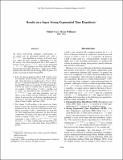| dc.contributor.author | Vyas, Nikhil | |
| dc.contributor.author | Williams, Ryan | |
| dc.date.accessioned | 2022-07-21T15:56:32Z | |
| dc.date.available | 2022-07-21T15:56:32Z | |
| dc.date.issued | 2020 | |
| dc.identifier.uri | https://hdl.handle.net/1721.1/143932 | |
| dc.description.abstract | <jats:p>All known SAT-solving paradigms (backtracking, local search, and the polynomial method) only yield a 2n(1−1/O(k)) time algorithm for solving k-SAT in the worst case, where the big-O constant is independent of k. For this reason, it has been hypothesized that k-SAT cannot be solved in worst-case 2n(1−f(k)/k) time, for any unbounded ƒ : ℕ → ℕ. This hypothesis has been called the “Super-Strong Exponential Time Hypothesis” (Super Strong ETH), modeled after the ETH and the Strong ETH. We prove two results concerning the Super-Strong ETH:1. It has also been hypothesized that k-SAT is hard to solve for randomly chosen instances near the “critical threshold”, where the clause-to-variable ratio is 2k ln 2 −Θ(1). We give a randomized algorithm which refutes the Super-Strong ETH for the case of random k-SAT and planted k-SAT for any clause-to-variable ratio. In particular, given any random k-SAT instance F with n variables and m clauses, our algorithm decides satisfiability for F in 2n(1−Ω( log k)/k) time, with high probability (over the choice of the formula and the randomness of the algorithm). It turns out that a well-known algorithm from the literature on SAT algorithms does the job: the PPZ algorithm of Paturi, Pudlak, and Zane (1998).2. The Unique k-SAT problem is the special case where there is at most one satisfying assignment. It is natural to hypothesize that the worst-case (exponential-time) complexity of Unique k-SAT is substantially less than that of k-SAT. Improving prior reductions, we show the time complexities of Unique k-SAT and k-SAT are very tightly related: if Unique k-SAT is in 2n(1−f(k)/k) time for an unbounded f, then k-SAT is in 2n(1−f(k)(1−ɛ)/k) time for every ɛ > 0. Thus, refuting Super Strong ETH in the unique solution case would refute Super Strong ETH in general.</jats:p> | en_US |
| dc.language.iso | en | |
| dc.publisher | Association for the Advancement of Artificial Intelligence (AAAI) | en_US |
| dc.relation.isversionof | 10.1609/AAAI.V34I09.7125 | en_US |
| dc.rights | Article is made available in accordance with the publisher's policy and may be subject to US copyright law. Please refer to the publisher's site for terms of use. | en_US |
| dc.source | Association for the Advancement of Artificial Intelligence (AAAI) | en_US |
| dc.title | Results on a Super Strong Exponential Time Hypothesis | en_US |
| dc.type | Article | en_US |
| dc.identifier.citation | Vyas, Nikhil and Williams, Ryan. 2020. "Results on a Super Strong Exponential Time Hypothesis." Proceedings of the AAAI Conference on Artificial Intelligence, 34 (09). | |
| dc.contributor.department | Massachusetts Institute of Technology. Computer Science and Artificial Intelligence Laboratory | |
| dc.contributor.department | Massachusetts Institute of Technology. Department of Electrical Engineering and Computer Science | |
| dc.relation.journal | Proceedings of the AAAI Conference on Artificial Intelligence | en_US |
| dc.eprint.version | Final published version | en_US |
| dc.type.uri | http://purl.org/eprint/type/ConferencePaper | en_US |
| eprint.status | http://purl.org/eprint/status/NonPeerReviewed | en_US |
| dc.date.updated | 2022-07-21T15:50:09Z | |
| dspace.orderedauthors | Vyas, N; Williams, R | en_US |
| dspace.date.submission | 2022-07-21T15:50:10Z | |
| mit.journal.volume | 34 | en_US |
| mit.journal.issue | 09 | en_US |
| mit.license | PUBLISHER_POLICY | |
| mit.metadata.status | Authority Work and Publication Information Needed | en_US |
